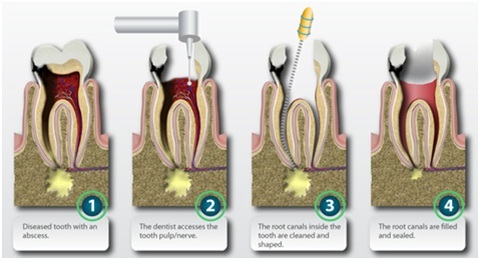Restorative Dentistry is fixing decayed, broken, and infected teeth.
Fillings, crowns, bridge, root canal, implant, denture
Fillings
After damage has been done to the tooth from decay or fracture, the tooth can be restored to the natural shape. This can be done with economical silver amalgam material or with tooth colored composite resin material.
Crowns (Cap)
Crowns are used to strengthen and improve the look of a tooth. Every time a tooth needs a filling it becomes slightly weaker. When about 50% of the tooth has been replaced with filling material, the chance for tooth fracture becomes much higher. Usually a tooth with a root canal treatment is at this stage as well. A crown can then be made to completely surround, cover, strengthen, and protect the tooth.
Bridges
A Bridge can be used to replace missing teeth. The teeth on either side of the gap are prepared similar to a crown. When finished there is one piece that is cemented onto the teeth on each side of the gap.
Root Canal Treatment
Root canal treatment is necessary when the nerve (pulp) inside the tooth has become infected or deadened. This can happen from trauma or decay. Sometimes if a tooth gets hit too hard or broken too deep, the pulp becomes irritated and then necrotic. Other times, decay expands deep enough into a tooth and the bacteria infects the pulp. Sometimes this results in pain and swelling.
The tooth is then treated by accessing the pulp chamber, finding the canals, cleaning and shaping the canals, and then finally a root filling material is placed.
Extractions
Extractions are the removal of teeth. This can be necessary for many reasons. If a tooth is unable to be saved, then it must be removed.
Most teeth can be numbed with local anesthesia and taken out painlessly. Missing teeth can easily be replaced with something removable, fixed, or implanted.
Scaling/Root Planing
This is for the patient with untreated gum disease. It is a “deep” cleaning of the teeth and roots. It is something the patient gets numb for so that we can get deep in the gum pockets without patient discomfort. After this treatment, the gums have a chance to heal. This type of patient will normally come in for a regular cleaning every 3 months.
Implants
Implants used to be the future of replacing missing teeth, but now they are currently the best long term solution. In many cases of missing teeth, a titanium implant can be placed in the bone. After that heals and integrates, an abutment and tooth can be placed on top of it. They function and look like a normal tooth.
Implants can also be used to hold partial and full dentures in place.
Dentures
Full and partial dentures can be used to replace missing teeth. They are custom designed for every patient to ensure the best fit as possible. An upper complete denture is often very stable but a lower complete denture can be held in place with mini implants. Partial dentures use natural teeth for stability and support but also can use mini implants as extra or primary support.




